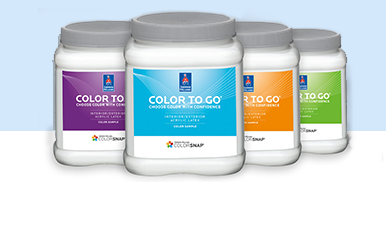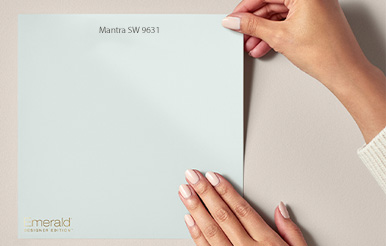Recent Questions
Answer While the higher quality brushes provide a better finish and would last a long time when used by the infrequent painter, bristles can wear, especially when used to coat rough surfaces. For example, if you're applying a solvent-based stain with a natural china bristle brush over rough sawn clapboard, you may wear out one or more brushes if coating many linear feet of board. However, the ability of the brush to load and release product still makes it well worth the expense. This being said, if coating over a smooth surfaces, the brush can last through many projects.
Answer Some will use an medium sheen, such as our Eg-Shel or Satin finishes. These will offer improved washability as compared to a flat finish while not developing as high a sheen as semi-gloss products. Another option, if you prefer a low or flat finish, is Duration Home®. This product comes in either flat, stain or semi gloss, but offers stain resistance in all sheen levels. Your neighborhood Sherwin-Williams store can provide you with more details on this product.
Answer Conventional floor coatings will not acquire sufficient adhesion to a ceramic tile floor. A professional contractor could be called in to completely scarify the surface. Once the ceramic finish is completely removed, it may be possible to treat the surface as a masonry or concrete surface.
Answer A good quality brush is well constructed, offers better quality (and, often, a greater number of) bristles, holds and releases paint better and minimizes brush marks. Be sure to clean the brush thoroughly with the appropriate cleaner. From time to time, a solvent brush cleaner can be used to maintain the bristles.
Answer While every effort is made to ensure uniformity of color, the fact remains that paint products, tint products, and even tinting equipment, all operate within specified tolerance levels. This means that there is a possibility that cans of paint bought at different times may not match exactly.If and/or when you realize that you will not have enough paint to complete a full coat over the entire space, we recommend that you stop at a natural break, such as a corner, window or door opening. Then go purchase additional product. If you're painting the final coat and you anticipate that you may need to touch up some of the areas already coated, take some product from the original material and set it aside (be sure to label it so that you can identify which areas it was used on). Take the remainder of the original paint and mix it with the new product before continuing.
Answer When painting wood there is a balance that needs to be achieved. Wood is constantly expanding and contracting with changes in the environment. The harder and more durable the finish, the more rigid and less forgiving to movement it can be. On the other hand, paint materials that are very flexible are not hard enough to handle the foot traffic.Taking this into consideration, it is best to paint this surface with our Porch & Floor Enamel. An oil-based alternative such as our All Surface Enamel Oil can also be used, especially where more abrasion is anticipated. In a common entry, it may be necessary to touch up the traffic area every year or two while the rest of the surface may last longer. Some have found it advantageous to install a runner of some sort to minimize the maintenance of this surface.For a thinner film build system, we recommend our SuperDeck® Solid Stain.
Answer The general answer is yes. However, it is vital that the surface be properly prepared.If the surface may have been coated prior to 1978, please consider the following lead hazard cautionary statement:Warning! Removal of old paint by sanding, scraping or other means may generate dust or fumes that contain lead. Exposure to lead dust or fumes may cause brain damage or other adverse health effects, especially in children or pregnant women. Controlling exposure to lead or other hazardous substances requires the use of proper protective equipment, such as a properly fitted respirator (NIOSH approved) and proper containment and cleanup. For more information, call (in the U.S.) the National Lead Information Center at 1-800-424-LEAD or contact your local health authority.
Answer First calculate the actual square feet of space that will be coated. Then you will need to determine how many square feet a gallon of the intended product to be used will cover. Then it is just a matter of dividing the number of square feet to be covered by the number of square feet that a given product can cover. For example, if the product covers 400 square feet, and you are coating 1,000 square feet (1,000 divided by 400 = 2.5), you will need 2.5 gallons.400 square feet is theoretical because the texture of the substrate along with the material left on the applicator and other tools are not part of this calculation. This information is often available on the data page for the product as well.
Answer Yes, Our Bath Paint as well as Duration Home has been specially formulated to provide a mildew resistant finish in humid environments such as bathrooms. These tough durable finishes are suitable for use on interior walls, ceilings, and trim. Common household stains may be removed with nonabrasive cleaners. When applied according to label directions these products will resist mildew growth and will remain washable.
Answer Yes we do. After the brick has been cleaned to remove any contaminants from the surface with a heavy duty cleaner like TSP substitute and thoroughly rinsed apply one coat of a masonry primer. Once primed follow with two coats of interior acrylic latex semi gloss or satin paint. This material can resist temperatures up to 200ºF. Naturally this system is not for the firebox (not for direct contact with fire). Also, if flames are able to shoot out of the firebox there is a possibility of scorching the newly painted surface.
Answer Vertical ceramic tile (non-floor) in an area not subjected to extreme moisture (for example around the shower) should first be cleaned to remove all contamination. Usually a mild household detergent. Sand the surface to dull the finish (always wear a dust mask when sanding) then apply a coat of Adhesion primer. Follow with two coats of good quality latex paint. Naturally this system should be tested to ensure good adhesion before starting the whole project.
Answer Color and moods There has been much written on the affects of color on the moods of individuals. Behavioral psychology books may be a good source on this subject.Here are some general concepts:Warm Colors (Red, Yellow, and Orange) attract attention, create excitement, promote cheerfulness, and stimulates action.Cool Colors (Blue, Turquoise, Green, and Purple) relax and refresh, promote peacefulness, encourage and concentration.Light Colors (Off Whites, Light tones) make areas seem more spacious and tend to give people a psychological lift.Dark Colors (Deep tones) Make areas appear smaller and long exposure can create a feeling of monotony and depression.Bold Colors: Attracts the eye and creates excitement.Whites: Reflect more light and denote cleanliness. They can unite spaces.
Answer Enamel is a broad classification for finishing materials that dry to a smooth, hard finish and usually possess a gloss. In the past this term referred exclusively to oil base products, however, new generation latex products area also at times referred to as enamels. Because of these factors enamel as, a paint term has become somewhat ambiguous. Oil base products are those products that typically are composed of pigments dissolved in a mineral spirit such as paint thinner. While latex products are an emulsion suspended in water. The obvious differences are that oil base product require mineral spirits for clean up, have a longer dry time, and have a stronger odor while drying to a harder finish. Latex products typically will dry faster and are water clean up. Oil base products are used primarily where a harder finish is required. However, today's improved latex products have allowed for the substitution of latex in nearly all scenarios that had traditionally called for an oil base material.
Answer We typically do not recommend painting over wallpaper. However if you choose to, there are many issues to consider. The seams may not lie down properly. Moisture from the paint could cause blistering or peeling. Over a heavy vinyl the paint's adhesion may be minimal. The texture from the wallpaper may not look very good on a solid wall. Note that the seams may be visible in some areas. Any of these things could cause a problem. For these reasons we always recommend testing the system prior to taking on the whole job.Keeping in mind the points stated above, the only paper that may be primed is nonporous paper. If removal of the paper is not an option first clean the surface. Then lightly sand the seams to make them as smooth as possible. Test a quick drying alkyd primer like the Sherwin-Williams ProBlock Alkyd HS Primer on the wallpaper. If the primer dries without lifting or blistering, move to the next step of applying a finish coat over the primer.
Answer Older wood paneling can be painted. First clean the surfaces thoroughly. Our Heavy Duty Cleaner (a TSP substitute) or other good detergent will work. Often, even on this material, someone may have used polish or some other wax-based material making this cleaning necessary. If waxes exist, remove with ammoniated cleaners. Once dry, sand the surface to a smooth dull finish and remove all sanding dust. Once clean use ProBlock Alkyd HS to prime the surface. The oil base primer will help prevent bleeding. Follow with a good quality latex paint like our Super Paint Interior Acrylic Latex Paint. Naturally it would be good to test this system first on a small section prior to tackling the whole project.
Answer Scrape off all loose and peeling paint from the surface and wash the walls to remove any glue residue. If the drywall paper is damaged remove any loose paper and then use 80-120 grit sandpaper to lightly sand the area, this will feather the edges where the paper was removed. Then apply one coat of Sherwin-Williams Drywall Conditioner to the damaged areas. Our Drywall Conditioner is a clear, acrylic coating for sealing torn, ripped, and gouges drywall which occurs when wallcovering is removed. This product seals the torn facing or broken area and provides a suitable base for drywall patch, preventing blistering of the drywall paper under the patch. Allow 3 hours drying time before applying a skim coat, patch, new wallcovering, or primer to the surface.
Answer Vinyl surfaces can sometimes be difficult to coat. The composition of some of these surfaces prevents proper adhesion of paints. For best results we always recommend testing the system prior to taking on the whole job.First clean the surfaces thoroughly. Our Heavy Duty Cleaner (a TSP substitute) or other good detergent will work. Often, even on this material, someone may have used polish or some other wax-based material making this cleaning necessary. If waxes exist, remove with ammoniated cleaners. Test the Sherwin-Williams Multi-Purpose Latex Primer on the surface for adhesion. If the primer dries without lifting or blistering, you may then proceed and finish with a good quality latex paint like Super Paint or Duration.









